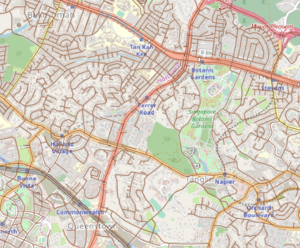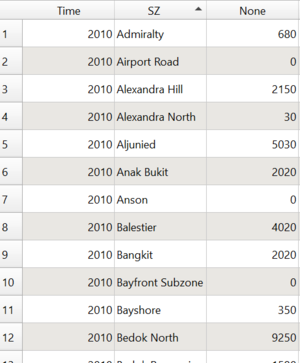Difference between revisions of "SMT201 AY2019-20T1 EX1 Renata Dharma"
Renatad.2018 (talk | contribs) |
Renatad.2018 (talk | contribs) |
||
| (3 intermediate revisions by the same user not shown) | |||
| Line 52: | Line 52: | ||
The layers' dependent visibility was scaled to a minimum of 1:50000. This ensures that the map does not take too long to render while it was initially opened and that only meaningful base maps were used. At a lower scale, there is a need to see the individual roads and buildings surrounding lanes or roads. However, at a higher level, it is better for the specific area in Singapore to be seen so as to aid analyzing frequency base on each neighbourhood. | The layers' dependent visibility was scaled to a minimum of 1:50000. This ensures that the map does not take too long to render while it was initially opened and that only meaningful base maps were used. At a lower scale, there is a need to see the individual roads and buildings surrounding lanes or roads. However, at a higher level, it is better for the specific area in Singapore to be seen so as to aid analyzing frequency base on each neighbourhood. | ||
| − | The image shows a map view at 1:50000 and another at map view 1:49999, where the planning area base map is visible. | + | The image shows a map view at 1:50000 (top) and another at map view 1:49999 (below), where the planning area base map is visible. |
[[File:Annotation at scale 1-50000.png|center|300px|map with scale 1-50000]] | [[File:Annotation at scale 1-50000.png|center|300px|map with scale 1-50000]] | ||
| Line 169: | Line 169: | ||
Classification: Natural Breaks (Jenks) <br> | Classification: Natural Breaks (Jenks) <br> | ||
Symbology: Colour Fill (grey)<br> | Symbology: Colour Fill (grey)<br> | ||
| − | + | Spatial pattern: From Map 5, the dark blue spots reveal that areas like Fernvale and Yio Chu Kang East and Kangkar are places with a decreasing number of citizens older than 65. On the other hand, subzones like Yio Chu Kang North, Kent Ridge, Pasir Ris, Bukit Merah experience a significant increase in the aged population. Taking this into account, it would be wise to evaluate redevelopment plans, ensuring that more elderly-friendly facilities are only added where the frequency of the aged population is high. Overall, it can be seen that Singapore is undergoing a silver tsunami. It is perhaps worth noting that an equal distribution of citizens by age can help foster more cohesive environments. | |
| − | Spatial pattern: | ||
===References=== | ===References=== | ||
| + | [1] https://data.gov.sg/dataset/school-directory-and-information <br> | ||
| + | [2] https://www.singstat.gov.sg/find-data/search-by-theme/population/geographic-distribution/latest-data <br> | ||
| + | [3] https://data.gov.sg/dataset/national-map-line <br> | ||
| + | [4] https://data.gov.sg/dataset/master-plan-2014-subzone-boundary-no-sea <br> | ||
| + | [5] https://data.gov.sg/dataset/master-plan-2014-land-use?resource_id=ea9f3b26-991f-48ea-ab58-e6b6d5fbaade <br> | ||
Latest revision as of 21:37, 15 September 2019
Part 1
| Stage 1 |
|---|
In the first stage, 1 data file was sourced:
Inside the datasets:
Data processing:
Visualising the layers:
|
| Stage 2 |
In the second stage, 2 data files were sourced:
Inside the datasets: From the Road Selection Line dataset, the entire country's Road System Network was obtained, which included the major and minor roads. From the National Map Line dataset, major features for national map data represented in polyline form were found. Data includes road data like expressway, major roads, international boundary and contour lines. Data Processing: The data were categorized into 3 different colours: yellow, green and blue. As the island contour lines did not apply to this stage of the Take-Home Exercise, it has been removed so that only Major Road, Expressways and Intersections were shown. Visualising the layers: The vector representing Major Roads, Expressways and Intersections have been modified to a larger width so that it is more obvious on the map. By making use of layer ordering, by placing (2) over (1), the non-overlapping vectors would represent the Minor Roads. |
| Stage 3 |
In the 3rd stage, 1 file was sourced:
Data Processing: The layer was modified to ensure consistent projection. Visualising the layers: The layers' dependent visibility was scaled to a minimum of 1:50000. This ensures that the map does not take too long to render while it was initially opened and that only meaningful base maps were used. At a lower scale, there is a need to see the individual roads and buildings surrounding lanes or roads. However, at a higher level, it is better for the specific area in Singapore to be seen so as to aid analyzing frequency base on each neighbourhood. The image shows a map view at 1:50000 (top) and another at map view 1:49999 (below), where the planning area base map is visible.
|
Part 2
| Stage 1 | ||||||||
|---|---|---|---|---|---|---|---|---|
In the first stage, these data files were sourced:
Inside the dataset:
Data Processing:
Part 2 Generated MapsThe above generated tables and columns were then used to join with the Master Plan 2014 Subzone Layer via the key attribute Subzone_N. Classification: Natural Breaks (Jenks) Classification: Natural Breaks (Jenks) Classification: Natural Breaks (Jenks) Classification: Natural Breaks (Jenks) Classification: Natural Breaks (Jenks) References[1] https://data.gov.sg/dataset/school-directory-and-information |



















